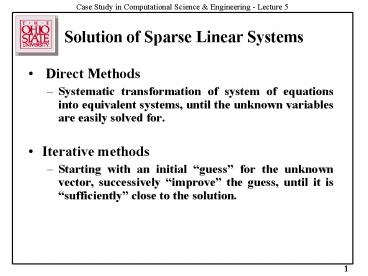Solution of Sparse Linear Systems - PowerPoint PPT Presentation
1 / 16
Title:
Solution of Sparse Linear Systems
Description:
LU Decomposition ... half as many arithmetic operations as LU decomposition. The forward and back-substitution process is the same as with LU decomposition. 5 ... – PowerPoint PPT presentation
Number of Views:67
Avg rating:3.0/5.0
Title: Solution of Sparse Linear Systems
1
Solution of Sparse Linear Systems
- Direct Methods
- Systematic transformation of system of equations
into equivalent systems, until the unknown
variables are easily solved for. - Iterative methods
- Starting with an initial guess for the unknown
vector, successively improve the guess, until
it is sufficiently close to the solution.
2
Direct Solution of Linear SystemsGaussian
Elimination
div by 2
(-1)
(-3)
- Unknowns solved by back-substitution after
Gaussian Elimination
3
LU Decomposition
- More efficient than Gaussian Eimination when
solving many systems with the same coefficient
matrix. - First A is decomposed into product A LU
- To solve linear system Axb, we need to solve
(LU)xb - Let zUx we have L(Ux)b, or Lzb. This can be
solved for z by forward-substitution. - Since Uxz, and z is now known, we can solve for
x by back-substitution.
4
Cholesky Factorization
- If A is symmetric and positive definite
, it can be factored in the form - Cholesky factorization requires only around half
as many arithmetic operations as LU
decomposition. - The forward and back-substitution process is the
same as with LU decomposition.
5
Sparse Linear Systems
- A significant fraction of matrix elements are
known to be zero, e.g. matrix arising from a
finite-difference discretization of a PDE - At most 5 non-zero elements in any row of the
matrix, irrespective of the size of the matrix
(number of grid points). - Sparse matrix is represented in some compact form
that keeps information about the non-zero
elements.
1 2 3 4 5 6 1 4 -1 0 -1 0 0 2 -1
4 -1 0 -1 0 3 0 -1 4 0 -1 -1 4 -1 0 0 4
-1 0 5 0 -1 0 -1 4 -1 6 0 0 -1 0 -1 4
6
Sparse Linear Systems
- For a 100 by 100 grid, with a finite difference
discretization using a 5-point stencil, less than
.05 of the matrix elements are non-zero.
1
n
1
Physical nxn Grid
7
Compressed Sparse Row Format
- A commonly used representation for sparse
matrices
0 1 2 3 4 5 0 4 -1 0 -1 0 0 1 -1
4 -1 0 -1 0 2 0 -1 4 0 0 -1 3 -1 0 0
4 -1 0 4 0 -1 0 -1 4 -1 5 0 0 -1 0 -1 4
rb
0 3 7 10 13 17 20
a
4 -1 -1 -1 4 -1 -1 -1 4 -1 -1 4
-1 -1 -1 4 -1 -1 -1 4
0 1 2 3 4 5 6 7 8 9 10 11
12 13 14 15 16 17 18 19
0 1 3 0 1 2 4 1 2 5 0 3
4 1 3 4 5 2 4 5
col
for (i 0 iltn i) for(jrbijltrbi1j)
yi ajxcolj Sparse MV Multiply
for (i 0 iltn i) for(j0jltnj) yi
aijxj Dense MV Multiply
8
Fill-in Non-Zeros
- During solution of sparse linear system (by GE or
LU or Cholesky), row-updates often result in
creation of non-zero entries that were originally
zero. - Row updates using row-1 result in fill-in
non-zeros (F).
9
Effect of reordering on fill-in
- Re-ordering the equations (rows) or unknowns
(columns) can result in significant change in the
number of fill-in non-zeros, and hence time for
matrix factorization.
Fill-in with GE
Reorder rows/cols
No fill-in with GE
10
Associated graph of matrix
- A graph-based view of matrixs sparsity structure
is extremely useful in generating low-fill
re-orderings. - The associated graph of a symmetric sparse matrix
has a vertex corresponding to each row/col. of
matrix, and an edge corresponding to each
non-zero matrix entry.
11
Fill-in and graph transformation
- Row-i updates row-j, jgti iff Aji is non-zero in
the associated graph a matrix non-zero
corresponds to an edge. - Row-update(i-gtj) could cause fill-in non-zero Ajk
corresponding to all non-zeros Aik. - After all updates from row-i, all neighbors of
vertex i in the associated graph form a clique.
l
l
i
i
j
j
k
k
12
Fill-in and graph transformation
- Each rows effect on fill-in generation is
captured by the clique transformation on the
associated graph. - The graph view is valuable in suggesting matrix
re-ordering approaches.
4
1
2
3
6
5
13
Matrix re-ordering Minimum Degree
- Graph-based algorithm for generating low-fill
re-ordering. - Matrix permutation is viewed as node-numbering
problem in associated graph. - Low-degree nodes are numbered early - so that
they are removed without adding many fill-in
edges. - For example, minimum-degree finds a no-fill
ordering.
14
Re-ordered matrix
1
4
5
6
3
2
15
Matrix re-ordering Nested Dissection
- Find a minimal vertex-separator to bisect
associated graph number those nodes last
recursively apply to both halves. - Property Given a numbering of nodes, fill-in Aij
exists, jgti, iff there is a path from i to j in
graph using only lower numbered vertices. - No fill-in edges between one half and other half
of partition.
16
Comparison of Ordering Schemes
Number of non-zeros after fill-in
Sparse matrix factorization time

